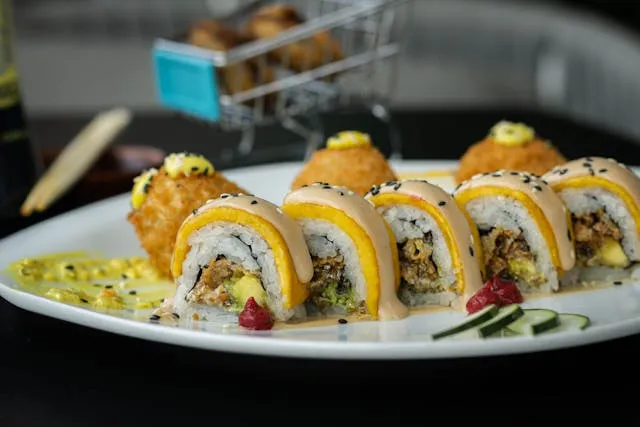Fusion cuisine is transforming how we dine today. From small cafés to upscale restaurants, chefs everywhere are mixing flavors from across the world. This global trend is reshaping what people expect from modern bistros and redefining the meaning of creativity on a plate. Many restaurants, like those offering the manga bistro menu, are leading the way by combining global cuisines with local charm.
Also Read: Aeonscope.net Gaming Scope Mix of Technology and precision
The Rise of Fusion Cuisine
Fusion cuisine isn’t just a buzzword. It’s a reflection of how global and open-minded modern dining has become. By blending cooking styles and ingredients from different cultures, chefs are creating unique dishes that excite every kind of diner.
From Korean tacos to Indian-inspired pasta, fusion meals give us something unexpected yet familiar. This creative approach has taken over the bistro scene because it keeps menus fresh, inviting, and constantly evolving.
A Global Palate in Local Bistros
Today’s food lovers are explorers. They crave diverse flavors and experiences that transport them across cultures without leaving their city. Local bistros have caught on, offering menus that bring the world to their tables.
Imagine enjoying Japanese sushi rolls infused with Latin American spices or French crepes stuffed with Thai curry. These combinations tell stories of travel, tradition, and innovation—all in one bite. Fusion cuisine gives diners something new while keeping the comfort of familiar ingredients.
Innovation Meets Tradition
The magic of fusion cuisine lies in balancing innovation with heritage. Chefs respect traditional cooking techniques but aren’t afraid to experiment. They might use Italian pasta-making skills with Korean gochujang sauces or French pastry techniques paired with Indian cardamom and saffron.
This creative mix keeps culinary traditions alive while making them relevant to today’s audience. Fusion cuisine proves that the old and the new can coexist beautifully.
The Influence of Social Media
Social media has played a major role in popularizing fusion dining. Food influencers love sharing vibrant, unusual dishes that spark curiosity. Platforms like Instagram and TikTok have made fusion food a global phenomenon.
A viral photo of a sushi burrito or a ramen burger can drive thousands of people to try it. This trend has encouraged modern bistros to be more daring and artistic in their presentations, blending cuisines not only for taste but also for visual appeal.
The Power of Cultural Exchange
Fusion cuisine is the culinary version of cultural dialogue. With immigration, travel, and international education, chefs are constantly exposed to new flavors and cooking traditions.
For example, the Mexican-Korean fusion trend began in Los Angeles and quickly spread across the world. Similarly, Indian-Chinese street food has become a comfort favorite across Asia. These combinations highlight how food unites people, builds communities, and celebrates diversity.
Health and Sustainability
Another reason fusion cuisine dominates the modern bistro scene is its focus on health and sustainability. Chefs are blending cuisines to create balanced, nutritious dishes that cater to health-conscious customers.
For instance:
- Replacing heavy cream sauces with Asian coconut milk
- Using Mediterranean herbs for natural flavor instead of salt
- Mixing plant-based proteins with international spices for vegan options
These choices align with the growing global movement toward eco-friendly and mindful eating. Fusion cuisine isn’t just delicious—it’s responsible dining.
The Modern Bistro: A Playground for Creativity
Bistros have become creative playgrounds for chefs who love to experiment. They combine the relaxed atmosphere of casual dining with the innovation of fine cuisine. Fusion menus allow them to test ideas and bring new excitement to their customers.
Picture a small café offering Korean barbecue sliders, Italian risotto with Mexican mole sauce, or Vietnamese coffee desserts. These aren’t just meals—they’re experiences that keep people talking, posting, and coming back for more.
Economic Advantages for Restaurants
From a business point of view, fusion cuisine makes perfect sense. It helps restaurants stand out in competitive markets and attract a broader audience. Unique fusion dishes often become signature items, driving customer loyalty and free publicity.
Bistros can also optimize their ingredient use. For example, the same sauce or spice blend can appear in multiple fusion dishes, reducing waste and increasing creativity. This combination of innovation and practicality is why many small eateries have embraced the trend wholeheartedly.
The Psychology Behind Fusion Dining
Why do people love fusion food so much? The answer lies in psychology. Humans naturally enjoy novelty and comfort—fusion dishes offer both.
When diners see something familiar, like pasta, paired with something exotic, like Thai peanut sauce, it triggers curiosity. They feel adventurous yet safe. This emotional satisfaction makes the dining experience memorable and enjoyable.
The Future of Fusion Cuisine
Fusion cuisine is more than a passing fad—it’s the future of dining. As global connections deepen, the blending of food traditions will only continue. Modern bistros, with their flexible menus and intimate settings, are the perfect stage for this culinary evolution.
Expect to see exciting combinations ahead, such as:
- African-Asian fusion soups
- Nordic-Indian desserts
- Latin-European breakfast creations
Each new combination tells a story about creativity, culture, and connection.
Conclusion
Fusion cuisine has taken over the modern bistro scene because it represents freedom, diversity, and imagination. It lets chefs express themselves, brings communities together, and gives diners unforgettable experiences.
From the bistro menu to neighborhood cafés around the world, fusion dining reflects who we are today—a generation open to change, eager to explore, and hungry for something extraordinary.
So the next time you enjoy a dish that feels both familiar and foreign, remember: it’s not just food. It’s a fusion of worlds, ideas, and emotions—served on a single plate.

